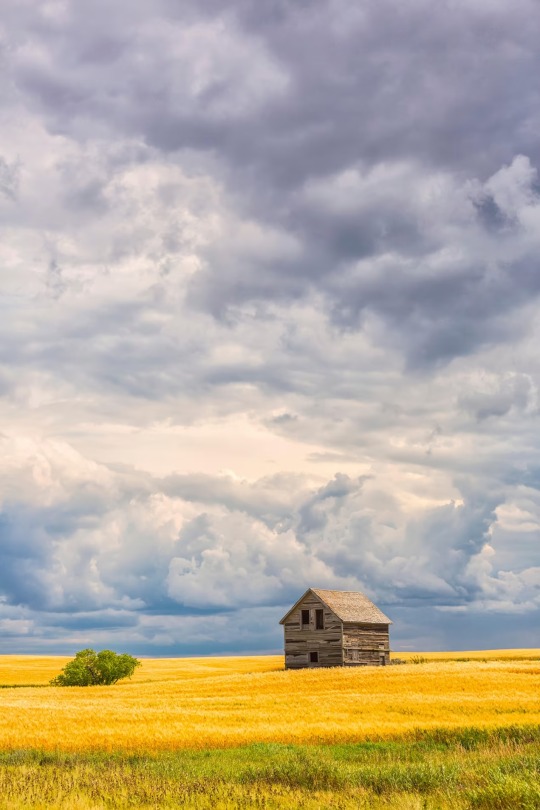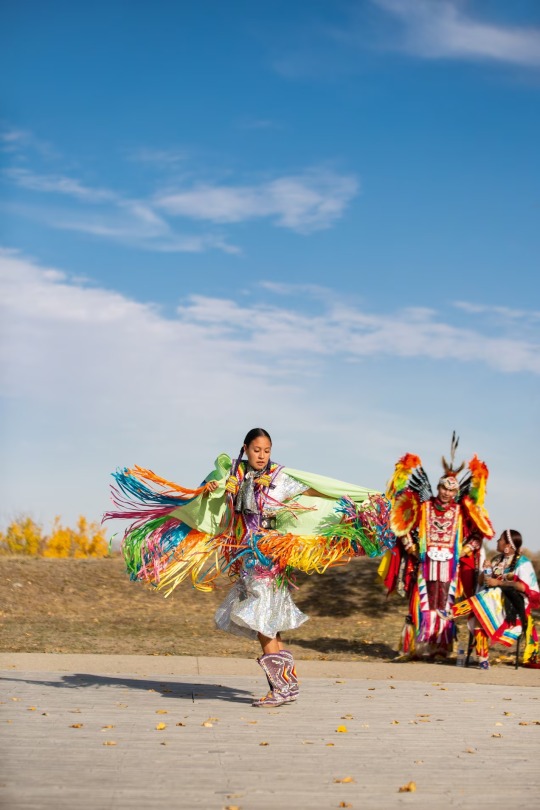#Blackfoot Cree Ojibwa Assiniboine Nakota and Dakota
Explore tagged Tumblr posts
Text

Bison calves stand in Saskatchewan’s Wanuskewin Heritage Park, the first to be born in the the Archaeological Site and Cultural Centre in more than 150 years. Photo By WanuskewinHeritage Park
How Canadian Bison Have Been Brought Back From The Brink In Saskatchewan
In Saskatchewan’s Wanuskewin Heritage Park, bison are a vital piece of the indigenous cultural history and have been brought back from the brink to help rewild fragile grasslands.
— By Karen Gardiner | Published June 3, 2023 | July 29th, 2025
Dr. Ernie Walker has heard enough tired takes on Saskatchewan’s flat landscape. “A lot of people refer to the prairies as big and empty or useless,” he says, indignant, as he leads me around Wanuskewin Heritage Park, an archaeological site and cultural centre 15 minutes from the Saskatchewan city of Saskatoon. “That’s not it. What’s significant about the prairies is that it’s subtle.”
Standing under a big blue sky, amid dry rolling grassland that stretches uninterrupted all the way to the horizon, I think I understand the misconception: lacking mountains and with sparse trees, this isn’t exactly the type of landscape that wallops you with its dramatic features. But if there’s anyone who can convincingly argue for the value of this place, it’s Walker.
The park’s founder and chief archeologist, Walker has spent four decades with his hands in Wanuskewin’s dirt, turning up artefacts — including stone and bone tools, amulets and even gaming pieces — that have whispered to him stories of this land’s significance. Working here as a ranch hand in the early 1980s, he convinced his boss that the land had great archaeological importance. That slowly set in motion the park’s establishment, which involved a rare-for-the-time collaboration between Indigenous and non-Indigenous people.
“When visitors look at the landscape, I’m always interested in what they’re actually seeing,” Walker continues. “They need to know the story behind this place.” The story here is of 6,000 years of almost uninterrupted human occupation. That narrative was drummed into the land by millions of bison hooves until the animals met a violent end. But now, the bison are back and they’re writing a new chapter.

An abandoned building stands along the roads of rural Saskatchewan. Photo By Design Pics Inc, Alamy
A Place of Sanctuary
In the Nēhiyawēwin (Plains Cree) language, ‘Wanuskewin’ roughly translates as ‘sanctuary’. Lying at the fertile confluence of the South Saskatchewan River and Opimihaw Creek, it was a gathering place for the people of the Northern Plains — the Blackfoot, Cree, Ojibwa, Assiniboine, Nakota and Dakota — who all followed bison herds and found sustenance and shelter here. Before European settlement, this land was home to vast numbers of bison (also known as buffalo) and the multitudes of species they supported, from the insects that thrived in the bison’s manure and the birds that fed on those insects to the humans that were dependent on the bison’s meat and skin.
But then came catastrophe. Bison were deliberately slaughtered to near extinction, a tactic used by settlers to starve Indigenous people into submission. “Around 400 years ago, there were 26 to 30 million bison on the Great Plains in North America,” Walker says. “By the 1890s, there were just 1,200.”
With the bison and their way of life gone, Plains people were left with little choice but to sign Treaty Six, an 1876 agreement with the British Crown that opened up the land for European settlement and promised one square mile of land to every Indigenous family of five. They were then corralled onto reserves.
“What if I were to come to all of your houses, empty your fridges and say you guys have to move to the s****y part of town?” Wearing a fringed buckskin waistcoat adorned with beaded flowers, Jordan Daniels, a member of the Mistawasis Nêhiyawak (Cree) Nation, raises his voice above the prairie wind to ensure we understand the depth of his ancestors’ loss. I’ve left Walker for now and joined a small group along Wanuskewin’s bison viewing trail where we’ll see and learn about Wanuskewin’s reestablished herd.
“The bison were a central part of our existence,” Daniels explains. “We made our teepees out of them. They were a main food source. Everything we needed for sustenance came from these animals.” There was also an emotional connection. Many Indigenous people consider bison kin, and the animal is ubiquitous in Indigenous stories and art. “They played a central role in our beliefs and in our way of seeing the world around us,” explains Daniels.
Bringing back the bison to Wanuskewin was always the park’s founders’ dream. In 2019, the animals finally came home. Six calves from Saskatchewan’s Grasslands National Park established the herd, followed by an additional five animals from the United States with ancestral ties to Yellowstone National Park. The herd, which has grown to 12, is now helping to restore native grasses. North America’s grasslands are one of the most endangered biomes in the world and bison, a keystone species, can help restore balance between animals, land and humans.
While grazing, Daniels explains, bison’s hooves aerate soil and help to disperse seeds, and by wallowing (rolling around), they create depressions that fill with rainwater and stimulate plant growth and provide habitat for microorganisms, amphibians and insects. “They’re ecologically unmatched,” he says. “But, I feel, nothing outweighs the cultural factor of having bison back here.”
Daniels’ connection is intensely personal. He explains that his seven-times great grandfather was Chief Mistawasis, the first chief in Saskatchewan to sign on to Treaty Six. Before signing, Daniels says, Mistawasis “had spent his life living how our people have done since time immemorial, out on the plains hunting bison. And today, I’m able to look at animals that are genetically close to the ones that he’d have interacted with. It’s a very impactful and powerful thing.”

Tianna McCabe, a Navajo, Arapaho and Cree powwow dancer, explains the significance of her ornate regalia. Photo By Concepts/KareeDavidsonPhotography.Com
Happy To Be Home
Wanuskewin is about protecting the future as much as preserving the past. I meet with young Indigenous people who demonstrate aspects of their cultures, once suppressed, now thriving. Tianna McCabe, a Navajo, Arapaho and Cree powwow dancer, explains the significance of every fabric and colour of her ornate regalia before hopping her way through an Old Style Fancy Shawl dance, her feet landing with each staccato beat of a drum.
As the day eases into night, I follow a group to the top of a bluff to meet Métis chef Jenni Lessard, who’s prepared our Han Wi (‘moon dinner’ in Dakota language). As well as bison tenderloin, sourced from a nearby farm and seasoned with yarrow and sage, we eat pickled spruce tips and bannock bread with chokecherry syrup. Sipping wild mint and fireweed tea, we gather around a fire, rejoined by Dr Ernie Walker to hear “a miraculous story”.

Dezaray Wapass, a Fancy Shawl dancer, performs in Wanuskewin National Park. Photo By Concets/KareeDavidsonPhotography.Com
In August 2020, Walker was visiting the bison herd when he noticed a boulder protruding from a patch of vegetation the animals had worn away. Seeing a groove cut across the top of it and, brushing away the dirt, he spotted more cuts and realised what he was seeing was a petroglyph. The boulder turned out to be a ‘ribstone’, so-called because its engraved motifs represent bison ribs. Three more petroglyphs were later unearthed, as well as the stone knife used to carve them.
What the bison did when they uncovered those petroglyphs was to complete the story of Wanuskewin. “We’d always lamented that, here in the park, we’ve got [archeological sites like] buffalo jumps, teepee rings and North America’s most northerly medicine wheel, but we didn’t have any rock art,” explains Walker.
Wanuskewin is on the tentative list for UNESCO World Heritage designation. The discovery of the petroglyphs, Walker believes, has boosted its chances. He tells me: “The stones complete everything you’d expect to find on the Northern Plains, but you don’t usually find those things within walking distance of each other.”
Dressed in a white Stetson, blue jeans and cowboy boots, Walker retains the appearance of a young ranch hand but, after 40 years of arguing for this place, I sense he’s content to rest a little. “I’ve told this story many times before,” he says. Now, the bison have picked up Wanuskewin’s epic story and it’s time to let them tell it once again.
#Canadian Bison#Saskatchewan#Wanuskewin Heritage Park#Archaeological Site and Cultural Centre#Dr. Ernie Walker#Chief Archeologist#Nēhiyawēwin (Plains Cree) Language#Wanuskewin (Sanctuary)#Blackfoot Cree Ojibwa Assiniboine Nakota and Dakota#Jordan Daniels#Mistawasis Nêhiyawak (Cree) Nation#Indigenous People#Grasslands National Park#Tianna McCabe a Navajo Arapaho and Cree Powwow Dancer 💃#Old Style Fancy Shawl Dance 💃#Métis chef Jenni Lessard#Han Wi (‘Moon Dinner’ in Dakota Language)#Chokecherry Syrup#Petroglyphs#UNESCO World Heritage
10 notes
·
View notes